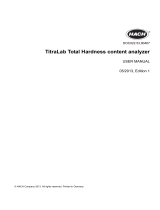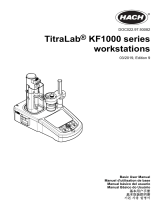Page is loading ...

DOC022.52.93082
TitraLab
®
KF1000 series workstations
User Manual
12/2014, Edition 1


Table of Contents
Section 1 Specifications.................................................................................................................... 3
Section 2 General information......................................................................................................... 5
2.1 Safety information........................................................................................................................ 5
2.1.1 Use of hazard information................................................................................................... 5
2.1.2 Precautionary labels............................................................................................................ 5
2.1.3 Certification......................................................................................................................... 6
2.2 Product overview.......................................................................................................................... 6
2.3 Instrument connections................................................................................................................ 7
2.4 Product components.................................................................................................................... 8
Section 3 Installation.......................................................................................................................... 9
3.1 Installation guidelines................................................................................................................... 9
3.2 Connect to AC power................................................................................................................... 9
3.3 Install the syringe......................................................................................................................... 9
3.4 Install the sensor storage tubes................................................................................................. 11
3.5 Install the sensor holder accessories......................................................................................... 11
3.6 Prepare the tubes....................................................................................................................... 11
3.7 Connect the tubes...................................................................................................................... 11
3.8 Install the sensor........................................................................................................................ 12
3.8.1 Connect the sensor........................................................................................................... 12
3.9 Install the titrant and the reagent................................................................................................ 13
3.10 Tidy the work area.................................................................................................................... 14
3.11 Install accessories.................................................................................................................... 14
3.11.1 Install an external pump.................................................................................................. 14
3.11.2 Install an external propellor............................................................................................. 15
3.11.3 Install PC software.......................................................................................................... 15
Section 4 User interface and navigation......................................................................................17
4.1 Keypad....................................................................................................................................... 17
Section 5 Startup............................................................................................................................... 19
5.1 Configure the instrument............................................................................................................ 19
5.1.1 Change the application settings........................................................................................ 19
5.2 Install the applications................................................................................................................ 22
5.3 Prepare the instrument for measurement.................................................................................. 23
Section 6 Standard operations...................................................................................................... 25
6.1 Get a sample measurement....................................................................................................... 25
6.2 Cell management....................................................................................................................... 26
6.3 Manage the data log.................................................................................................................. 27
6.4 Calibration.................................................................................................................................. 27
6.4.1 Calibrate the titrant............................................................................................................ 27
6.5 Purge..........................................................................................................................................27
Section 7 Maintenance..................................................................................................................... 29
7.1 Maintenance schedule............................................................................................................... 29
7.2 Clean the instrument.................................................................................................................. 29
7.3 Clean the sensor........................................................................................................................ 29
7.4 Regenerate the molecular sieve................................................................................................ 30
7.5 Replace syringe electro-valve block........................................................................................... 30
7.6 Maintenance menu..................................................................................................................... 31
7.6.1 Syringe activation.............................................................................................................. 31
7.6.2 Pump activation................................................................................................................. 31
7.6.3 Syringe replacement......................................................................................................... 31
7.6.4 Pump cassette replacement.............................................................................................. 31
1

7.6.5 Other maintenance options............................................................................................... 32
7.7 Storage and transportation......................................................................................................... 33
7.7.1 Prepare the instrument for short-term storage.................................................................. 33
7.7.2 Prepare the instrument for long-term storage................................................................... 33
7.7.3 Prepare the instrument for shipment................................................................................. 33
Section 8 Troubleshooting..............................................................................................................35
Section 9 Replacement parts and accessories.......................................................................... 37
Table of Contents
2

Section 1 Specifications
Specifications are subject to change without notice.
Specification Details
Dimensions (W x D x H) 22 x 40 x 36 cm (8.7 x 15.7 x 14.2 in.)
Weight 4 kg (8.8 lb)
Power requirements 100–240 VAC, 50/60 Hz
Altitude 2,000 m (6,562 ft) maximum
Operating temperature 15 to 35 °C (59 to 95 °F)
Relative humidity 20 to 80%, non-condensing
Storage temperature –5 to 40 °C (23 to 104 °F)
Installation category II
Pollution degree 2
Certifications Safety IEC/EN 61010-1; EMC IEC/EN 61326-1
Warranty 1 year (EU: 2 years)
3

Specifications
4

Section 2 General information
In no event will the manufacturer be liable for direct, indirect, special, incidental or
consequential damages resulting from any defect or omission in this manual. The
manufacturer reserves the right to make changes in this manual and the products it
describes at any time, without notice or obligation. Revised editions are found on the
manufacturer’s website.
2.1 Safety information
N O T I C E
The manufacturer is not responsible for any damages due to misapplication or misuse of this
product including, without limitation, direct, incidental and consequential damages, and disclaims
such damages to the full extent permitted under applicable law. The user is solely responsible to
identify critical application risks and install appropriate mechanisms to protect processes during a
possible equipment malfunction.
Please read this entire manual before unpacking, setting up or operating this equipment.
Pay attention to all danger and caution statements. Failure to do so could result in serious
injury to the operator or damage to the equipment.
Make sure that the protection provided by this equipment is not impaired. Do not use or
install this equipment in any manner other than that specified in this manual.
2.1.1 Use of hazard information
D A N G E R
Indicates a potentially or imminently hazardous situation which, if not avoided, will result in death
or serious injury.
W A R N I N G
Indicates a potentially or imminently hazardous situation which, if not avoided, could result in
death or serious injury.
C A U T I O N
Indicates a potentially hazardous situation that may result in minor or moderate injury.
N O T I C E
Indicates a situation which, if not avoided, may cause damage to the instrument. Information that
requires special emphasis.
2.1.2 Precautionary labels
Read all labels and tags attached to the instrument. Personal injury or damage to the
instrument could occur if not observed. A symbol on the instrument is referenced in the
manual with a precautionary statement.
This symbol, if noted on the instrument, references the instruction manual for operation and/or safety information.
This symbol indicates that a risk of electrical shock and/or electrocution exists.
5

This symbol indicates the presence of devices sensitive to Electro-static Discharge (ESD) and indicates that care
must be taken to prevent damage with the equipment.
Electrical equipment marked with this symbol may not be disposed of in European public disposal systems after
12 August of 2005. In conformity with European local and national regulations (EU Directive 2002/96/EC), European
electrical equipment users must now return old or end-of-life equipment to the Producer for disposal at no charge to
the user.
2.1.3 Certification
Canadian Radio Interference-Causing Equipment Regulation, IECS-003, Class A:
Supporting test records reside with the manufacturer.
This Class A digital apparatus meets all requirements of the Canadian Interference-
Causing Equipment Regulations.
Cet appareil numérique de classe A répond à toutes les exigences de la réglementation
canadienne sur les équipements provoquant des interférences.
FCC Part 15, Class "A" Limits
Supporting test records reside with the manufacturer. The device complies with Part 15 of
the FCC Rules. Operation is subject to the following conditions:
1. The equipment may not cause harmful interference.
2. The equipment must accept any interference received, including interference that
may cause undesired operation.
Changes or modifications to this equipment not expressly approved by the party
responsible for compliance could void the user's authority to operate the equipment. This
equipment has been tested and found to comply with the limits for a Class A digital
device, pursuant to Part 15 of the FCC rules. These limits are designed to provide
reasonable protection against harmful interference when the equipment is operated in a
commercial environment. This equipment generates, uses and can radiate radio
frequency energy and, if not installed and used in accordance with the instruction manual,
may cause harmful interference to radio communications. Operation of this equipment in
a residential area is likely to cause harmful interference, in which case the user will be
required to correct the interference at their expense. The following techniques can be
used to reduce interference problems:
1. Disconnect the equipment from its power source to verify that it is or is not the source
of the interference.
2. If the equipment is connected to the same outlet as the device experiencing
interference, connect the equipment to a different outlet.
3. Move the equipment away from the device receiving the interference.
4. Reposition the receiving antenna for the device receiving the interference.
5. Try combinations of the above.
2.2 Product overview
The instrument operates with digital and analog sensors. Measurement applications are
installed on the instrument to automate the measurement process. Instructions show on
the display when user intervention is required. Refer to Figure 1 for product features.
General information
6

Figure 1 Product overview
1 Keypad 6 Beaker 11 Sensor holder
2 Display 7 Syringe protection cover 12 Pump 2 input/output (waste)
3 Sensor storage tubes 8 Syringe input/output 13 Pump 1 input/output (solvent)
4 USB port 9 Tube clips 14 Pump access cover
5 Sample stopper 10 Syringe
Table 1 Instrument configuration
Model Syringes Pumps
KF1121 1 2
2.3 Instrument connections
Figure 2 shows the connections on the rear panel of the instrument. Use the USB port on
the side of the instrument for the USB applications key supplied with the instrument. Use
the USB port on the rear of the instrument to connect to a printer, mouse, keyboard or a
USB hub.
Figure 2 Instrument connections
1 24 V external power supply port 4 Not used 7 USB port
2 Sensor 1 port 5 Not used 8 Ethernet port
3 Sensor 2 port 6 Serial port
General information
7

2.4 Product components
Make sure that all components have been received. Refer to the packing list in the box. If
any items are missing or damaged, contact the manufacturer or a sales representative
immediately.
Figure 3 Contents of the instrument box
1 Instrument 3 Sensor storage tubes (3x) 5 Power cord
2 Sample stopper 4 Power supply
Figure 4 Contents of the application box
1 KF standard beaker 6 Syringe holding ring
2 KF white Teflon
®
conical adapter 7 Syringe
3 Magnetic stir bars (10x) 8 Glass bottle
4 USB applications key 9 Bottle caps (3 x GL45)
5 Sensor 10 Desiccant cartridges (3x)
1
1
2 filled with a molecular sieve, and 1 empty
General information
8

Section 3 Installation
C A U T I O N
Multiple hazards. Only qualified personnel must conduct the tasks described in this
section of the document.
3.1 Installation guidelines
• This instrument is for indoor use only.
• The power supply connector on the rear panel must be easily accessible so the
power can be disconnected quickly in case of emergency.
• Keep the instrument away from temperature extremes, including heaters, direct
sunlight and other heat sources.
• Put the instrument on a stable and level surface in a well ventilated place.
• Make sure that there is at least 15 cm (6 in.) of space on all sides of the instrument to
prevent electrical parts from overheating.
• Do not operate or keep the instrument in dusty, damp or wet locations.
• Always keep the surface of the instrument and all accessories dry and clean.
3.2 Connect to AC power
D A N G E R
Electrocution hazard. If this equipment is used outdoors or in potentially wet locations, a
Ground Fault Circuit Interrupt (GFCI/GFI) device must be used for connecting the
equipment to its main power source.
C A U T I O N
Electrical shock and fire hazards. Make sure that the supplied cord and non‐locking plug
meet the applicable country code requirements.
W A R N I N G
Fire hazard. Use only the power supply that is specified for this instrument.
1. Connect the power cord to the power supply.
2. Connect the power supply to the instrument. Refer to Figure 2 on page 7.
3. Connect the power cord to an electrical outlet.
3.3 Install the syringe
Before syringe installation, set the instrument power to on. Push the power button on the
front of the instrument. Make sure that the startup sequence shows on the display. The
syringe holder lowers to its operating position.
Note: Ignore any warning messages related to missing applications that show on the display.
The sensor holder has two positions: one over the magnetic stirrer and the second at
180° to the right. Move the sensor holder away from the instrument to the second
position.
Refer to the illustrated steps that follow.
9

Installation
10

3.4 Install the sensor storage tubes
Put the three sensor storage tubes into the holder that is on the side of the instrument.
Refer to Figure 1 on page 7.
3.5 Install the sensor holder accessories
Add the stir bar to the beaker, and then attach the beaker to the sensor holder. Install the
desiccant cartridge and the sample stopper. Refer to the illustrated steps that follow.
3.6 Prepare the tubes
Remove any bends in the end of the tubes. Refer to the illustrated steps that follow.
3.7 Connect the tubes
Arrow symbols identify the inlet and outlet ports for the syringe and the pump
connections. The “up” arrow is the outlet port. The “down” arrow is the inlet port. Turn the
tube connectors on the inlet and outlet ports of the syringe and pump until they click.
The suction tube that drains into the waste bottle must be installed on the bottom of the
beaker for good drainage.
N O T I C E
The diffusion tip and tube holder on the outlet tube, are pre-installed at the optimal positions. Do
not change the position of the diffusion tip or the tube holder.
Refer to the illustrated steps that follow.
Installation
11

3.8 Install the sensor
3.8.1 Connect the sensor
Use a conical adapter to hold the sensor tightly in the sensor holder. Make sure the
conical adapter is installed correctly. This makes sure of a secure water-tight fitting in the
sensor holder and the tip of the sensor will be in the correct position in the beaker.
Connect the sensor to an available sensor port on the rear of the instrument. After the
sensor is connected, make sure that the sensor icon shows in the banner at the top of the
display. Refer to the illustrated steps that follow.
Installation
12

3.9 Install the titrant and the reagent
C A U T I O N
Chemical exposure hazard. Obey laboratory safety procedures and wear all of the
personal protective equipment appropriate to the chemicals that are handled. Refer to the
current safety data sheets (MSDS/SDS) for safety protocols.
Loosen the tube connector on the bottle cap.
Put a filled desiccant cartridge into the adapter on the titrant and solvent bottle caps. Put
an empty desiccant cartridge into the adapter on the waste bottle cap.
Note: The molecular sieve in the filled cartridges must be regenerated regularly depending on the
humidity of the laboratory. Refer to Regenerate the molecular sieve on page 30.
Push the inlet tube through the connector. Make sure that the end of the tube is at the
bottom of the bottle. Tighten the connector on the bottle cap.
Pump 1 is used to fill the measurement cell with solvent. Pump 2 is used to empty the
measurement cell. Refer to the illustrated steps that follow.
Installation
13

3.10 Tidy the work area
Attach the tubes to the instrument with the clips on the electrovalve and the sensor
holder. Refer to the illustrated steps that follow.
3.11 Install accessories
3.11.1 Install an external pump
This accessory (Item no. LZE142) is used to remove unwanted sample from the beaker.
Installation
14

1. Remove any bends in the end of the tube from the inlet port on the pump.
2. Push the tube into a tube holder slot so it is correctly attached.
3. Make sure that the end of the tube is near the bottom of the beaker.
4. Make sure that the tube from the outlet port of the pump is installed in an applicable
container.
5. Connect the pump to the external pump port on the rear of the instrument (refer to
Figure 2 on page 7).
3.11.2 Install an external propellor
This accessory (Item no. LZE143) is used as an alternative to the standard magnetic stir
bar, for more viscous samples.
1. Install the propellor into an available slot on the sensor holder.
2. Make sure that the end of the propellor is near the bottom of the beaker.
3. Connect the propeller to the external propeller port on the rear of the instrument (refer
to Figure 2 on page 7).
3.11.3 Install PC software
The optional PC software connects with the TitraLab
®
workstation through an Ethernet
network. The software can be used to:
• Control a TitraLab
®
workstation to start and stop analyses
• Control a sample changer to start and stop analyses
• Control a balance for accurate sample weighing
• Show run-time data directly from the workstation
• Manage data stored locally or on a server (search, compare, delete, print, etc.)
• Export data to files for use in other software applications
Full product documentation and on-line help is available with the software.
Refer to Figure 5 for a typical PC setup that includes connections to a balance, printer,
TitraLab
®
workstation and sample changer.
Figure 5 Typical setup that can be used with the PC software
1 Balance for weighing the sample 4 TitraLab
®
workstation
2 Printer 5 Sample changer
3 Computer with PC software installed
Installation
15

Installation
16

Section 4 User interface and navigation
4.1 Keypad
Figure 6 shows the keypad and gives the key functions.
Figure 6 Keypad
1 Power 4 Navigation keys
2 Printer 5 Home
3 Selection keys
Key Description
Power Sets the instrument power to on or off. Push the key for 2 seconds to set the power to off.
Printer Sends data to an attached printer. The printer key only operates if a printer is connected to the
instrument.
Selection keys
(contextual)
Shows the measurement options, selection and confirmation options. Use this key to exit the current
menu display or open sub-menus. Available options show on the display above each key.
Navigation keys Scrolls through menus and data, enter numbers and letters, enter checkbox settings and set options
for the syringe and the pump.
Home Goes to the main menu.
17

User interface and navigation
18
/






